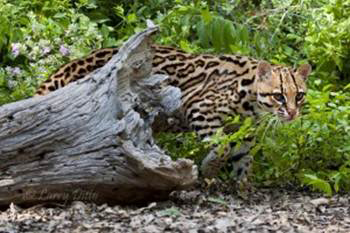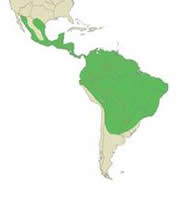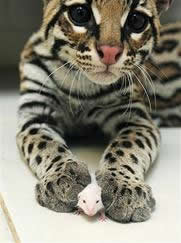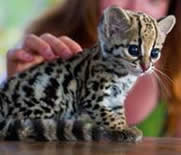Ocelot
Leopardus pardalis

Taxonomy:
Kingdom: Animalia
Phylum: Chordata
Class: Mammalia
Order: Carnivora
Family: Felidae
 Description:
Description:
Ocelots are about twice the size of a house cat. They tend to be 37 to 58 inches long, 16 to 20 inches tall, and weigh between 24 and 35 pounds. They have big eyes and rounded ears. The base color of their coat varies by habitat. They are covered in blotches, stripes, and whirls. They have white bellies that may have spots and they have banded tails.
 Range/Habitat:
Range/Habitat:
Ocelots range from the extreme Southern United States to Northern Argentina. They are found in every Central American and South American country except Chile. Ocelots are a relatively adaptable animal, occupying a variety of habitats. Their habitats may include mangrove forests, coastal marshes, savanna grasslands, pastures, thorn scrub, and tropical forests.
 Behavior:
Behavior:
Ocelots are generally solitary animals. They tend to be nocturnal but it is not uncommon for them to be out during the day too. They mostly hunt on the ground, but can also catch prey in the trees, and because they are good swimmers they may also fish.
 Diet:
Diet:
Their diet may consist of small deer and peccaries, fish, rodents, rabbits, monkeys, birds, and reptile.
Reproduction:
Ocelots reach sexual maturity at 20 to 24 months. They may breed at any time usually once or twice a year. Their gestation period typically lasts 70 days. They may give birth to 1 to 4 kittens. These kittens will begin hunting with their mother at 6 months and will not hunt alone until they are 18 to 24 months old.
Lifespan:
Ocelots live 10-13 years in the wild and up to 20 years in captivity.
Personal Interest:
The ocelot are beautiful creatures and my absolute favorite animals. I was excited to have this opportunity to research them.
Reference
Please note that the following references may have either been removed or relocated by the webpage owners since the time this student report was created.
Ocelot Leopardus Pardalis. National Geographic, 2013. Web. 30 May 2013.
<http://animals.nationalgeographic.com/animals/mammals/ocelot/>.
Caso, A., Lopez-Gonzalez, C., Payan, E., Eizirik, E., de Oliveira, T., Leite-Pitman, R.,
Kelly, M.& Valderrama, C. 2008. Leopardus pardalis. In: IUCN 2012. IUCN Red List of Threatened Species. Version 2012.2. <www.iucnredlist.org>.
Ocelot Facts and Information. Aquatic Community, 2009. Web. 30 May 2013.
<http://www.aquaticcommunity.com/ocelot/facts-information.php>.
Ditto, Larry. Caddo Lake and Prowling Ocelots. Wordpress Entries, 11 June 2012.
Web. 30 May 2013.< http://www.larryditto.com/wordpress/2012/06/11/caddo-lake-and-prowling-ocelots/>.
Vibber, Brion. Ocelots in Arizona?. High Country News, 2013. Web. 30 May 2013.
<http://www.hcn.org/issues/42.21/ocelots-in-arizona/image_viewer/3>.
Ocelot. Woodland Park Zoo, 2012. Web. 30 May 2013.
<http://www.zoo.org/page.aspx?pid=1891#.UagDCUA3uXt>.
Ponderful. Tumblr, 18 Dec. 2011. Web. 30 May 2013.
Not a Lot of Ocelots. N.p., n.d. Web. 30 May 2013.
<http://notalotofocelots.weebly.com/index.html>.